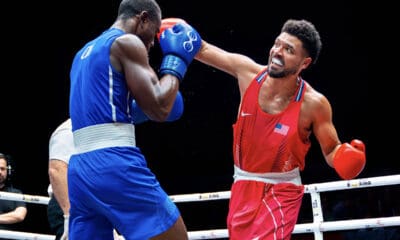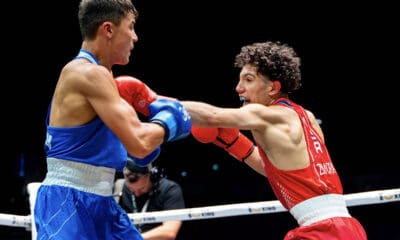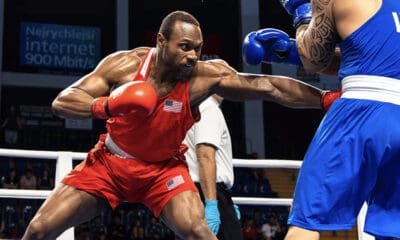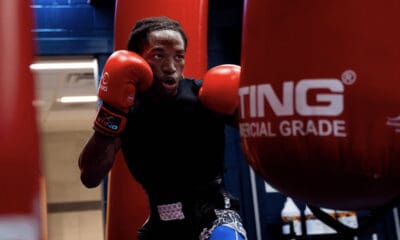The history of Montauk, New York is a testament to human resourcefulness.
From its earliest known inhabitants, the Native American Montauket tribe, to the development of a thriving fishing industry to its evolution as a high-end tourist destination, Montauk had to survive hurricanes and natural disasters along the way.
Today, monuments tell the story of Montauk’s tough and noble past. The most prominent is Montauk Harbor’s self-proclaimed dive bar, The Dock. Proprietor George Watson proudly represents the fighting spirit of Montauk’s rough and tumbled past.
Montauk’s Moment in Boxing History
Watson stands behind the bar, beneath a painting of a boxing match, the spoils of a bet his father once won. He still has the distinct movements of a fighter, albeit a little slower than the day he walked into this bar in 1973 and took over a run-down saloon called Fitzgerald’s.

George Watson (left) with boxing writer Matthew Pomara. Photo: Matthew Pomara
All these nights later, despite the toll the bar business can take on a man, he still moves with a sense of purpose.
When I talked with Watson and asked if he had ever been a boxer, Watson smiled and shared a book about a chilly November day in 1977.
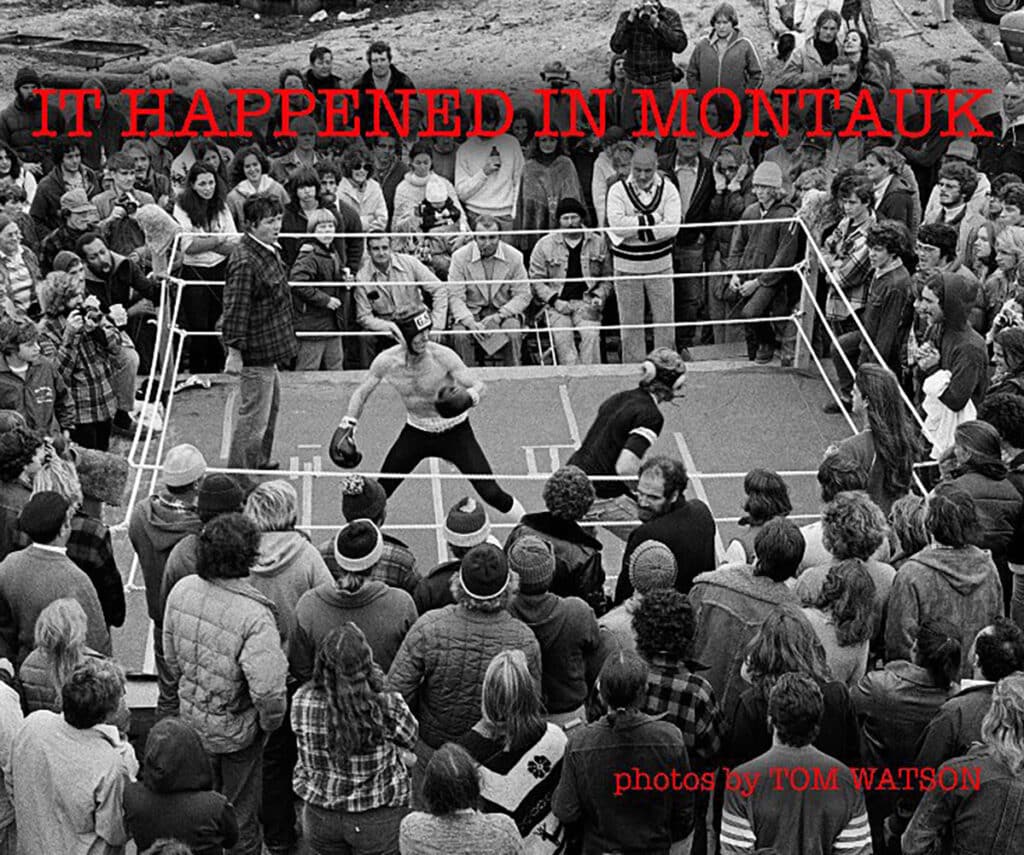
“It Happened in Montauk” tells the story of an epic amateur boxing staged in Montauk, New York in 1977.
“It Happened in Montauk” is a 2013 photo book written by George Watson’s brother, Tom Watson, featuring photos by Watson (a professional photographer). The book is described as “amateur boxing like you’ve never seen it.” It reveals the fighter’s essence at the heart of George Watson.
Every bar has a rogue’s gallery of wannabe tough guys. Heavyweight champion John L. Sullivan would reportedly enter a pub and declare, “I can lick any son of a bitch in this bar.”
Bar Room Brawls On Another Level
Occasionally, alcohol helps fuel the debate on who is the toughest. In November 1977, Watson was looking to find out in the most gentlemanly way possible an answer to this time-honored question: who is the toughest guy in my bar?
“Owning a bar, listenin’ to people bullshit how tough they were and all this other stuff. Once you’ve boxed you’re not afraid to do it. I had the confidence being a kid and doing it, I figured I could do it again,” said Watson.
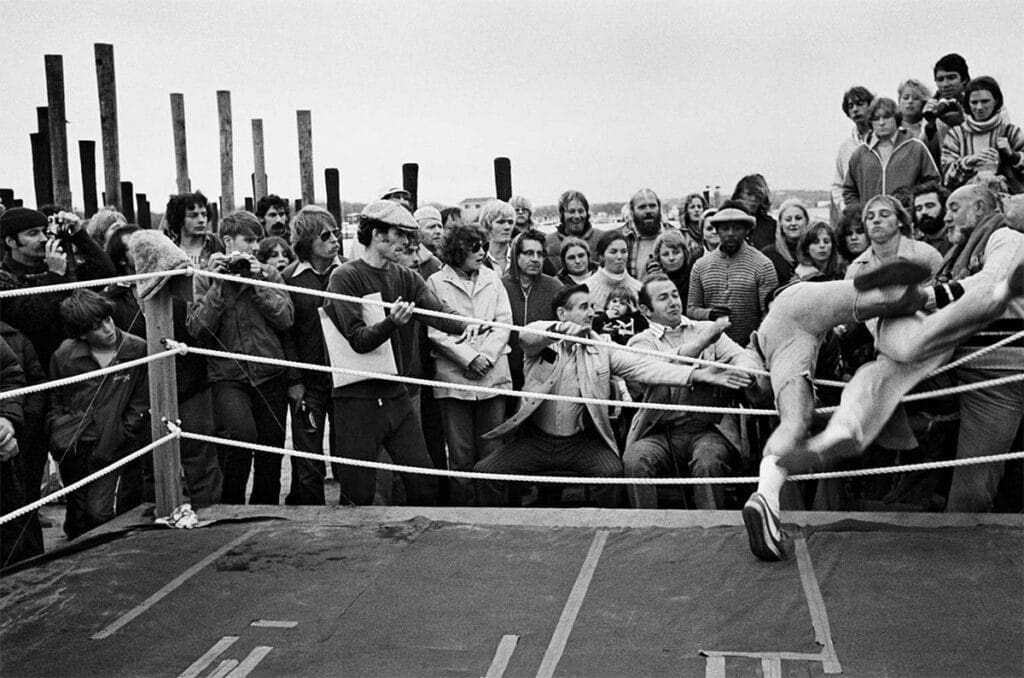
Steve Houseknecht and Mike Ushko fly through the ropes as fight judge Pat Sweeney looks on (center). Photo: Tom Watson
Watson learned to box in his family basement in Staten Island. His father was his first instructor.
That inspired him when he staged his first and only dock fight card on November 5, 1977. It brought together all the local tough guys to prove their mettle. “I started off with running races, rowing races, sailing races, and then I figured, why not?” said Watson.
“Today, they would put you in jail,” he chuckles, “but then, I just did it. We built a ring out there… and signed everybody up.”
A local carpenter constructed the ring right outside the bar. Today, a building sits on its east side.
Bar Owner Turns Boxing Promoter
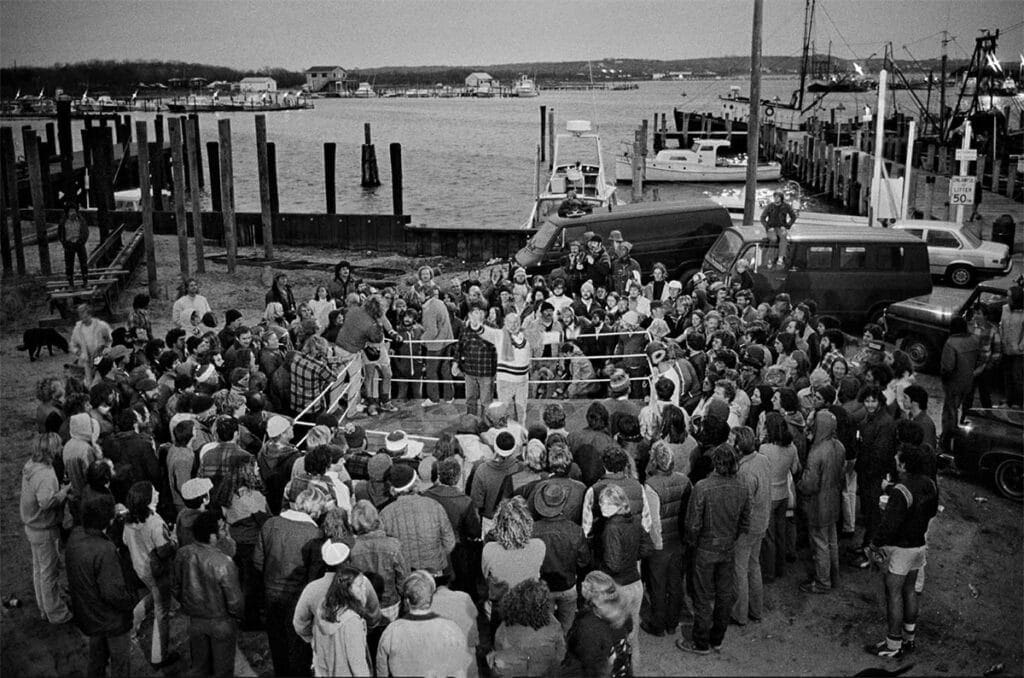
Ring announcer Rick Reilly with referee Charlie Kelly, addressing the crowd at the famed Montauk Dock Fights. Photo: Tom Watson
Watson had people volunteer, and he also recruited the best way he knew how, “I busted their balls into signing up. You’re a tough guy, let’s see what you can do.”
Watson wanted three-minute rounds, but he recognized how difficult that would have been from his own experience and went with two-minute rounds. Fighters used 16-ounce gloves. The names were put into a hat by weight class, and opponents were picked randomly.
Judges included Pat Sweeney, a former boxer, whose son would fight Watson on that day; the late assemblyman John Behan, who was not only a venerated politician and decorated war hero, but also a fight buff; and Rick Reilly, a public relations man who was also the ring announcer.
Charlie Kelly had experience as a fight referee. Judges didn’t score round by round; instead, they picked a winner for each fight.
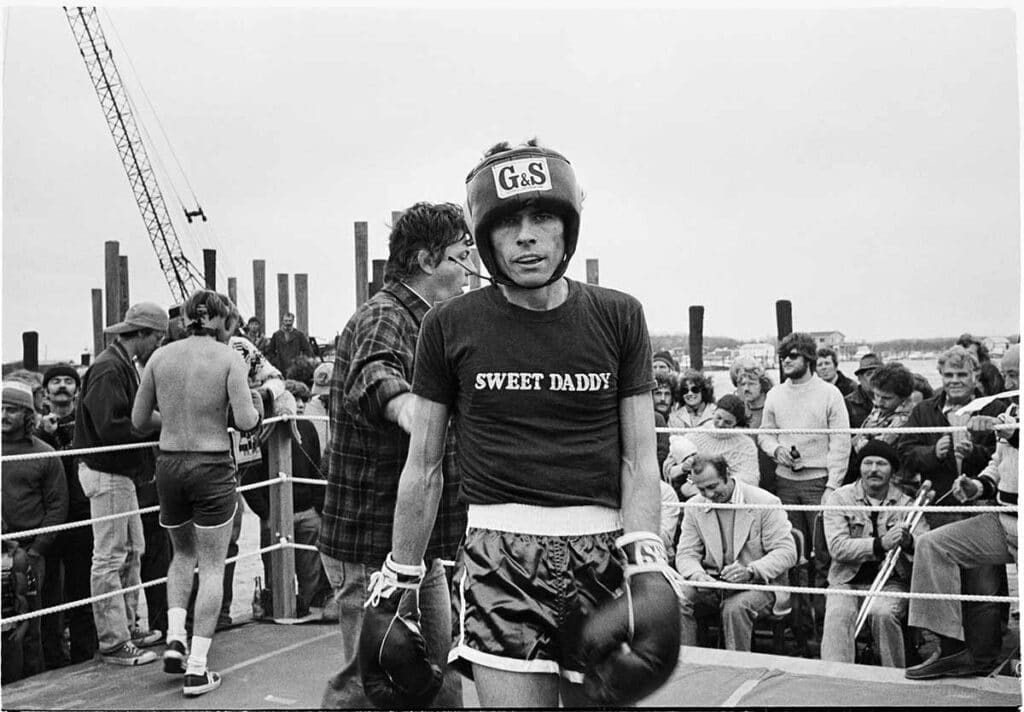
“Sweet Daddy” George Watson after the conclusion of his first fight. He would fight twice more that day. Photo: Tom Watson
Watson didn’t only stage the fights—he fought—THREE times. Between his fights, he weighed guys in and cleaned up glasses throughout the bar. He even set up lights on the roof of The Dock so the fights could continue into the cool fall evening.
Several participants fought multiple times at the event. “It was a crazy day,” said Watson.
Boxing Record 2-1 For Watson In A Single Day
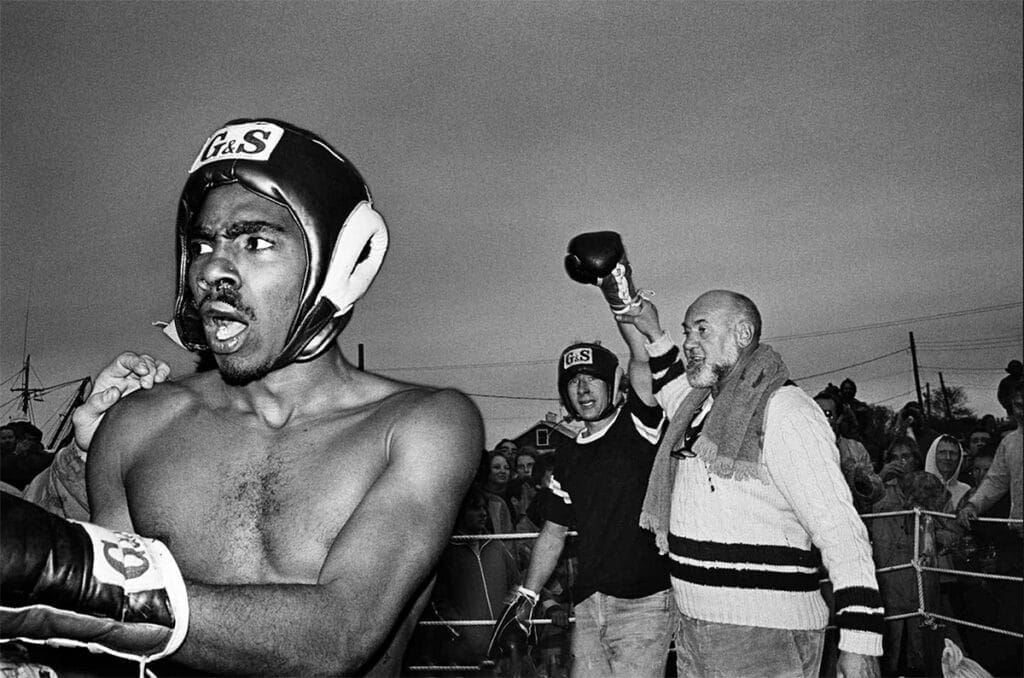
Robbery! U.S. Coast Guardsman loses to an unknown from Up Island as his hand is raised by ring announcer Rick Reilly. Photo: Tom Watson
Watson ended the day with a record of two wins and one loss. Watson beat John Sweeney. “He was a really nice kid, and I nailed him in the face,” he said.
He went the three rounds in distance in his first two fights. He lost in the first round of the final fight. “I was the first No Mas. The guy was a former gold glover,” laughed Watson, describing his opponent.
Watson considered making the event the first in a series. But one fight on the card convinced him for sure it would be one and done. It was a fight between two local tough guys named Charlie Whitmore of East Hampton and Brucie Erickson, a Montauk guy.
Heavyweight Mayhem in Montauk
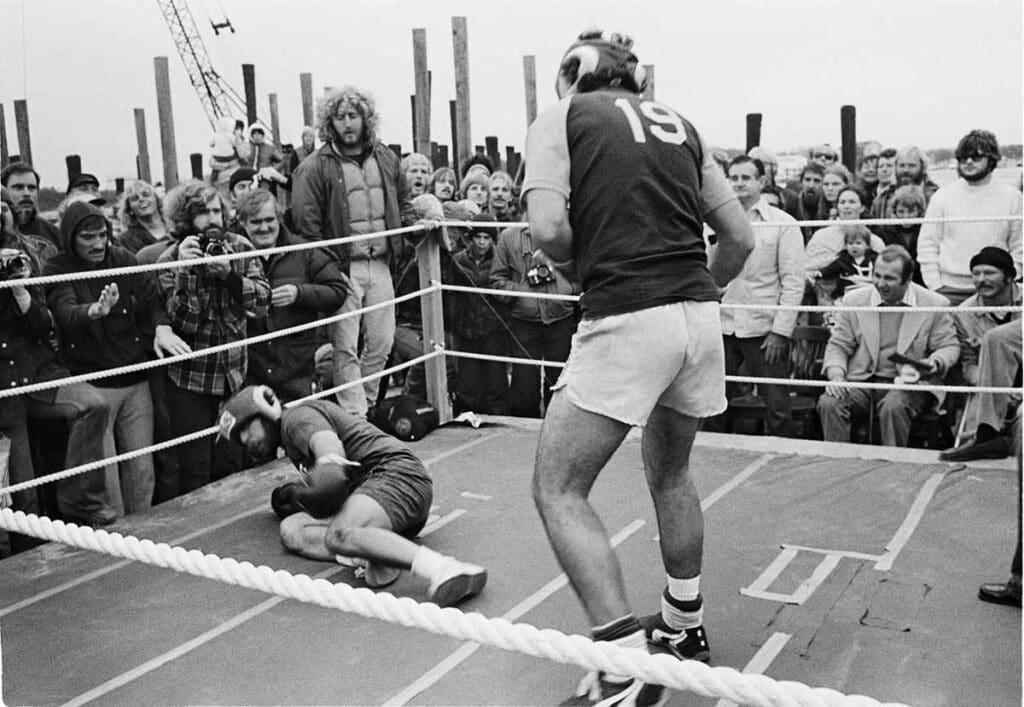
Tom McInerney stands over Bobby Izenburg after a knockdown. Photo: Tom Watson
Erickson was a hulking 240-pound heavyweight and a local legend as a notorious barroom brawler. The brawler facing off against the clean-cut, 190-pound college student Whitmore was a mismatch on paper.
Watson instructed referee Charlie Kelly his number one concern was that no one get seriously injured.
The fight started with a bang as Erickson overwhelmed Whitmore with a flurry of punches. Whitmore, trapped in a clinch, was unable to defend himself for nearly 40 seconds. Though Erickson’s initial aggression was impressive, his stamina waned after 30 seconds. Sensing the opportunity, Kelly stepped in to stop the fight.
The crowd, split between Whitmore’s East Hampton supporters and Erickson’s Montauk crew, erupted in protest. After a brief discussion, the fight resumed. However, Brucie Erickson’s earlier exertion had taken its toll.
“My father always told me, just last 30 seconds and the other guy will wear out and then it is oh baby,” Watson said. Whitmore, now rejuvenated, dominated the second round, forcing another stoppage.
“Of course everyone was oiling up, you know. Then I am going ‘holy shit, I don’t want a riot here!’ I was afraid people were going to start throwing stuff into the ring or something,” Watson recalls. There was no official security on hand that day.
Dock Fights Part of Montauk History
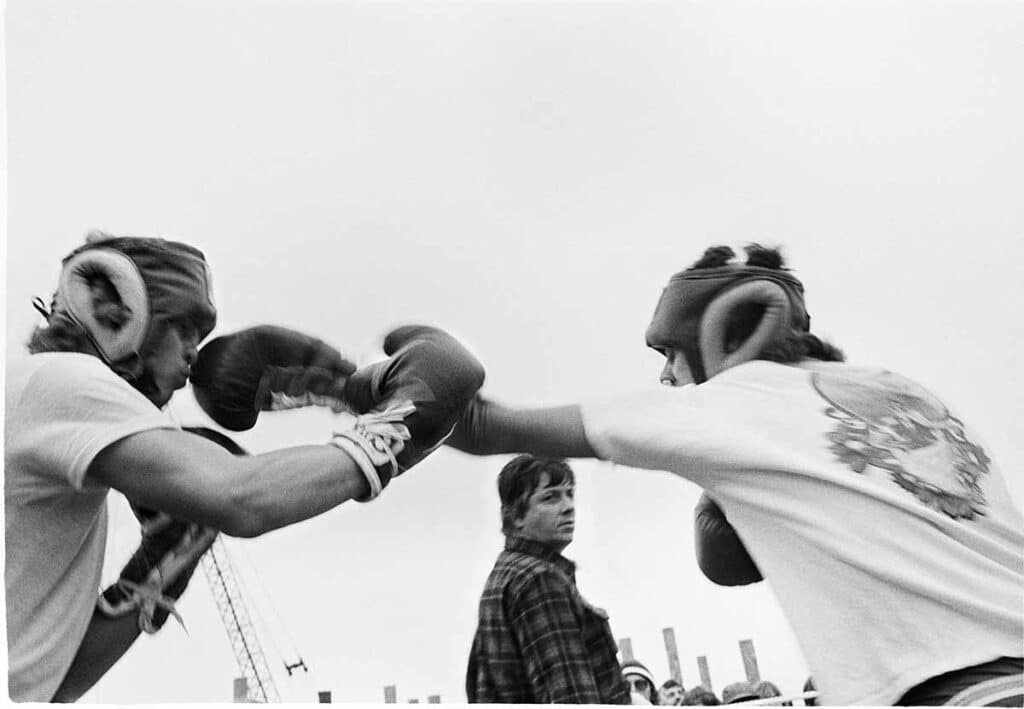
George Watson recruited tough guys like Danny Dalbora fighting Jimmy the Bricklayer at welterweight. Photo: Tom Watson
Watson’s favorite part of the night wasn’t his own impressive pugilistic exploits. It was teaching the bullies a lesson. “Nice part about (it), all the tough guys got beat up,” he laughed.
Watson’s only disappointment was losing the chance to beat up a bully himself. Watson wanted to battle a bricklayer named Jimmy. Like Watson, he was a welterweight. “He was a real asshole. I hated him, and he got his ass kicked by Danny Dalbora. I wanted to fight him.”
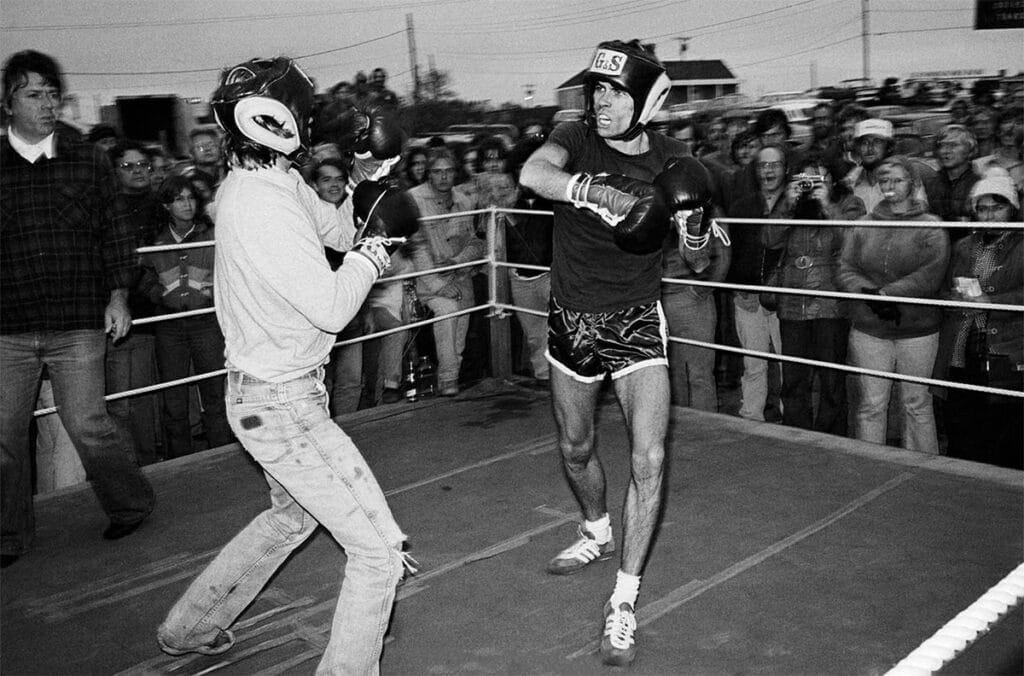
George Watson throws a punch at John Sweeney. Photo: Tom Watson
Before the end, Tom Watson unfortunately ran out of film. Many of the fights and results are lost to history.
There won’t be any more dock fights, but that day will remain as a testament to Montauk’s rough and tumble past and makes boxing itself very much a part of Montauk’s tough legacy.























